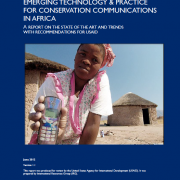Release of Geospatial Study Shows Improved Response to Disasters Using Mobile Phones
A recent study undertaken in Haiti found that mobile phones can deliver critical information on population movement rapidly and accurately following disasters.
Richard Garfield presented the findings from the research he conducted with several other public health specialists and social scientists at a recent mHealth working group meeting using data from mobile phone networks before and after the 2010 earthquake that rocked Haiti. The publication explains how the research team used position data of SIM cards from Haiti’s largest mobile phone company, Digicel, to estimate population movement trends following the earthquake and the subsequent cholera outbreak.
The researchers originally set out to find this data in order to respond to the disaster in Haiti. Knowing that 1 in every 3.8 people in Haiti owned a cell phone, they collaborated with Digicel to track the number of calls and the location of those calls over the course of a year, before and after the earthquake. Most mobile users were based in Port-au-Prince where the earthquake was centered. While cell reception was down for a few days immediately following the quake, the network capacity was rapidly re-established, making the phones easy to trace.
A 22 % decline in phone usage in Port-au-Prince after the quake correlated with the massive outflow of population from the capital, which was widely known. In the aftermath of the disaster, the UN and Haitian government had created maps based on eyewitness observation to track population movements. But because these were reliant on eyewitnesses, there was no way to tell how accurate the data was.
In fact, the mobile phone usage analysis showed different results from these official maps, showing movement that was more spontaneous and seemingly more accurate. Many of those who evacuated Port-au-Prince originally returned back within 7 days, and this was something the official numbers did not catch right away. Months after the earthquake when the UNFPA carried out a survey in Haiti to retrieve more accurate numbers of where people were and when, the mobile phone data was much more closely associated with these results. The mobile phone data also helped to estimate where the cholera outbreaks were happening and to get people out of the danger zones.

Estimated net changes of the Port-au-Prince population compared to the capital's population on the earthquake day
Garfield emphasized that while these results do not indicate that mobile data should be used as final, official counts on death tolls, it can provide initial estimates while waiting for more accurate counts. The key point is to mine the data rapidly and assist in a quick response.
Will this research lead to improved quick responses for future disasters? It certainly could be combined with current disaster relief efforts following the recent earthquake in Turkey, such as Google’s Person Finder app or social media response.






































